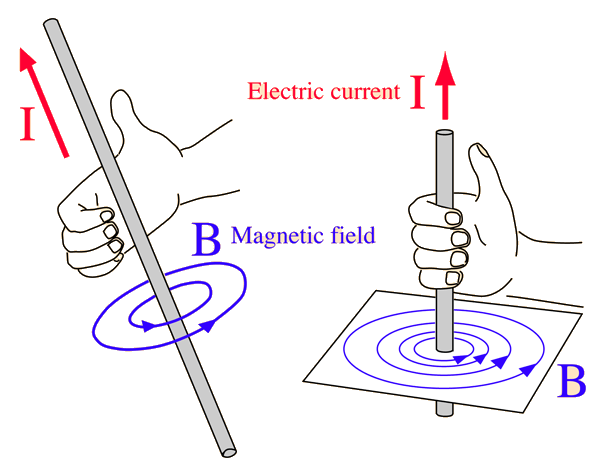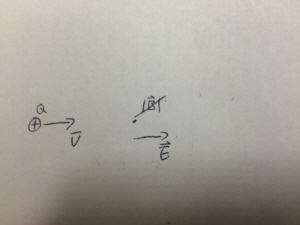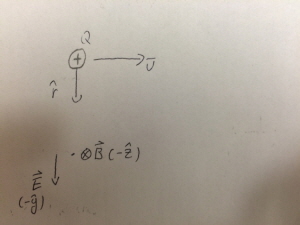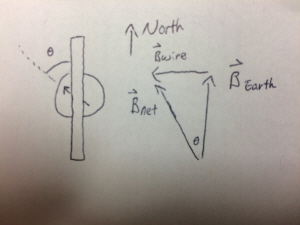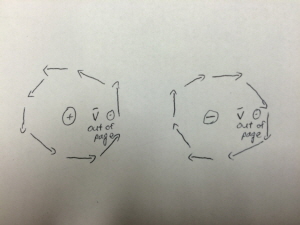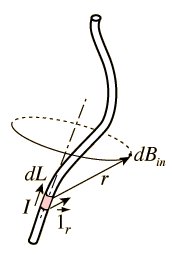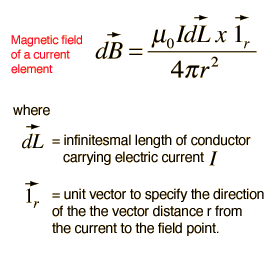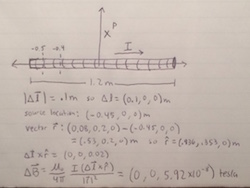Magnetic Field
Claimed by Seongshik Kim Spring 2016
edited by Giancarlo Rocca Fall 2016
Claimed by Yu Jun Qin Spring 2017
This page discusses the general properties and characteristics of magnetic fields
The Main Idea
Magnetic Field Due to Permanent Magnet

A permanent magnet refers to any object that produces its own magnetic field. The most commonly represented permanent magnet is the bar magnet, which generate fields that emerge from one end of the bar(dubbed the North pole) and enter through the other side(dubbed the South pole). A magnetic dipole, such as the bar magnet, generates a magnetic field very similar to the electric field generated by a electric dipole.
Magnetic Field Due to Moving Charge
Unlike electric fields, which focus on non-mobile charges, magnetic fields are made by moving charges. Stationary charges do not exert magnetic fields. In equilibrium, there is no net motion of charges inside a metal. Therefore, it should be noted that electrons inside a metal must move continuously in order to create a magnetic field. This is the very basic definition of the current, a non-equilibrium system in which there is a constant flow of electrons. Measuring electron current can be understood as counting the amount of electrons that pass through a particular cross section of a conductor. However, since it is extremely hard to count these electrons, we measure the current using other indirect methods, one being measuring the magnetic field.
To measure the direction of the magnetic field in comparison to the electric current, the RHR (right-hand rule) is very useful as shown in the image below.
Mobile charges generate an electric field perpendicular to the motion of the charge and direction of the observation location relative to the charge.
Before proceeding further into the discussion, recall that we defined equilibrium above as there being no net motion of charges inside a metal. Keep in mind that equilibrium and being continuous are two totally different things.
A Mathematical Model
The magnetic field created by a single charged particle is given by the equation [math]\displaystyle{ \vec{B} =\frac{\mu_0}{4\pi} \frac{q(\vec{v} \times \hat{r})}{|\vec{r}|^2} }[/math], where [math]\displaystyle{ \frac{\mu_0}{4\pi} }[/math], where [math]\displaystyle{ \frac{\mu_0}{4\pi} }[/math] is a fundamental constant equal to [math]\displaystyle{ 1 \times 10^{-7} T }[/math], [math]\displaystyle{ q }[/math] is the charge of the particle, [math]\displaystyle{ \vec{v} }[/math] is the velocity of the particle, and [math]\displaystyle{ \vec{r} }[/math] is the vector that points from source to observation location. This equation is called the Biot-Savart Law for a single moving charge.
There is, however, another version of this Biot-Savart Law. This definition focuses more on the electron currents that was explained in the introductory paragraph. It is defined by [math]\displaystyle{ \vec{B} =\frac{\mu_0}{4\pi} \frac{I(\vec{l} \times \hat{r})}{|\vec{r}|^2} }[/math]. You may notice these equations are very similar in format. The constants and the vectors are still the same, but in this equation, [math]\displaystyle{ I }[/math] is the conventional electron current in an observed wire and [math]\displaystyle{ \vec{l} }[/math] is the length of the segment of the wire.
The Vector Cross Product
The Biot-Savart law features the expression [math]\displaystyle{ \vec{v} \times \hat{r} }[/math]. The [math]\displaystyle{ \times }[/math] symbol does not refer to standard multiplication, but rather a form of vector multiplication called the cross product.
Given two vectors [math]\displaystyle{ \vec{a} }[/math] and [math]\displaystyle{ \vec{b} }[/math], [math]\displaystyle{ \vec{a} \times \hat{b} }[/math] calculates a third vector perpendicular to both vectors. The magnitude of this operation can be calculated as [math]\displaystyle{ \vec{a} \times \hat{b} = |a||b|\sin(\theta) }[/math]. More generally, one can find the cross product using the following formula. In the case where [math]\displaystyle{ \vec a \times \vec b = \lt ax, ay, az\gt \times \lt bx, by, bz\gt }[/math] [math]\displaystyle{ \vec a \times \vec b = \det \begin{bmatrix}\hat x & \hat y & \hat z \\ ax & ay & az \\ bx & by & bz \end{bmatrix} = \lt ay \times bz-az \times by, az \times bx-ax \times bz, ax \times by-ay \times bx\gt }[/math]
Right Hand Rule
As mentioned before, the right hand rule can be useful in determining magnetic field since it provides an easy solution to finding the direction of the field at a certain point. The technique for using the right hand rule is shown below.
 Note: All three vectors are meant to be perpendicular to each other.
Note: All three vectors are meant to be perpendicular to each other.
A Computational Model
The Biot-Savart Law defined above can be visualized if you click on the link below. The link sends you to a GlowScript page where you will be exposed to VPython code that animates both this law and its RHR applications. Simply click the "Run" botton at the top left of the frame to view.
<iframe src="https://trinket.io/embed/glowscript/7d28da9f50" width="100%" height="356" frameborder="0" marginwidth="0" marginheight="0" allowfullscreen></iframe>
Characteristics of the Biot-Savart Law
Single Charged Moving Particle Version
Because the equation involves the cross product of velocity and the position vector, one can find out that there is no magnetic field in the direction of the movement of the charged particle, because the cross product of two vectors in the same direction is zero.
However, even in the absence of a magnetic field, an electric field may still be present.
By using a compass, one can calculate the magnitude of a current. The Earth exerts a magnitude that always points to the North. When a compass is near a current with a magnetic field, the needle would be deflected by the net magnetic field. Notice that although the magnetic field of the current is perpendicular to the direction of the movement of charges, the needle is not deflected 90 degrees because of the magnetic field of the Earth, which is usually larger than that of the current. Also, because the magnetic field is exerted in a circular pattern, the direction of the magnetic field above the source is exactly the opposite of the magnetic field under the source. As a result, depending on the location of the compass, the needle may deflect in the opposite direction but with the same magnitude.
Lastly, Because of the direction of the magnetic field is influenced by the charge of the source, charge, in this case, one must pay attention to the presence of Q in the equation above.
Electric Current Version
Examples
Simple
1a. A current carrying wire running from North to South is placed on top of a compass. The current causes the compass needle to deflect 18 degrees clockwise.
Which way is the conventional current flowing?
A) North
B) East
C) South
D) West
E) No magnetic field present
Correct Answer:
Using the right hand rule, we get the answer to be C.
Middling
1b.A current carrying wire running from North to South is placed on top of a compass. The current causes the compass needle to deflect 18 degrees clockwise. The wire is located 8mm from the top of compass. What is the magnitude of the current running through the wire, given that the Earth's magnetic field is 2e-5 Tesla?
Note: Magnetic Field of a Long Straight Wire explains that a extremely long wire produces a magnetic field of [math]\displaystyle{ \vec{B} =\frac{\mu_0}{4\pi} \frac{2I}{|\vec{r}|} }[/math].
[math]\displaystyle{ \theta = \tan(\frac{\vec{B_of wire}}{\vec{B_of Earth}}) }[/math]
[math]\displaystyle{ \vec{B_of wire} = \vec{B_of Earth} \times arctan(\theta) }[/math]
[math]\displaystyle{ \vec{B} =\frac{\mu_0}{4\pi} \frac{2I}{|\vec{r}|} }[/math].
[math]\displaystyle{ I = \frac{4\pi}{\mu_0} \frac{\vec{B_of wire}|\vec{r}|}{2I} }[/math]
Ans =
2. A 1.2 m long wire is aligned and centered along the x axis with conventional current 9.5 A running West to East. An observation point P is located at (0.08,0.2,0) m. Calculate the magnetic field at P due to the wire between points (-0.4,0,0) m and (-0,5,0,0) m. It may help to draw a figure.
Correct Answer:
(0,0,5.92e-8) tesla
Connectedness
1. How is this topic connected to something that you are interested in?
This topic interests me most in the sense of using models to visualize complex ideas. The concept of a rotating magnetic field due to a moving particle in a wire is a very hard idea to grasp. Being able to depict this using VPython animation or graphical images with directional arrows is key to fully understanding such a phenomenon. In other words, something I have a keen interest in is enabling those who are not knowledgeable about a difficult subject to be able to grasp a solid interpretation of what is going on. So relating it to this topic, being able to visualize magnetic fields through the diagrams and code provided above is one step closer to enhancing my skills in translating difficult concepts.
2. How is it connected to your major?
As a Mechanical Engineer, I have to be able to visualize complicated situations, diagrams, and ideas. If I can't fully understand all the factors going on in a problem, then I won't be able to fulfill my ultimate purpose as an engineer: finding solutions to real-world problems. Thus, being able to communicate and display the complexities of a magnetic field, for example, is key to learning how to become a skillful ME.
3. Is there an interesting industrial application?
Yes! I actually currently have a co-op at Southwire Co. which is the leading copper producer in the world. I work in a plant where we extrude copper wire out and make your everyday cables for applications such as lamps, telephone lines, or wiring to your house. In the plant, there is a lot of machinery that can dangerously be affected if this copper product (major conductor of electric current and can produce large magnetic fields) if it is mishandled.
History
In 1819, Professor Hans Christian Oersted at Copenhagen University organized a home experiment consisting of a wire with an electric current and a compass. He discovered here that every time the current was switched on, the compass needle pointed at an angle from the wire. At the time, he could never figure out why that was but one year later, Jean-Baptiste Biot and Félix Savart ran similar experiments and found for themselves what would become the Biot-Savart Law, a key discovery for predicting the direction of magnetic field and magnetic force.
See Also
Magnetic Field of a Long Straight Wire
External Links
https://phet.colorado.edu/en/simulation/legacy/magnet-and-compass
http://hyperphysics.phy-astr.gsu.edu/hbase/magnetic/magfie.html
References
http://hyperphysics.phy-astr.gsu.edu/hbase/magnetic/magcur.html#c1
http://hyperphysics.phy-astr.gsu.edu/hbase/magnetic/Biosav.html#c1
